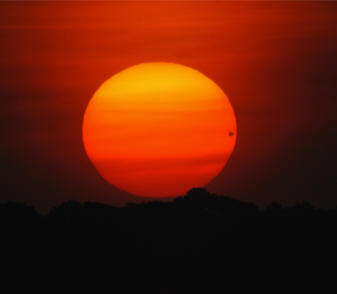|

Venus transiting the Sun
|
For April 2010, the Moon will be last quarter on April 6th. The waning crescent moon is passing about 5.5 degrees north of Jupiter on April 7th in morning twilight. The new moon occurs on April 14th. A very slender crescent moon passes a degree north of Mercury on April 16th, with much
brighter and easier to see Venus to the upper left of both.
The next evening, the crescent moon lies midway between Venus and the fine Pleiades star cluster, a fine photo op for any tripod mounted digital camera in nightshot mode. Earthshine lighting the dark upper part of the crescent should be a fine sight in binoculars as well this evening. The
first quarter moon sits just west of Mars overhead on April 21st. The waxing gibbous moon passes seven degrees south of Saturn in the east on April 25. The Full Moon, the Egg Moon, falls on April 28th.
Venus is low in the west just after sunset, and on Easter Sunday, Mercury sits three degrees north of much brighter Venus about an hour after sunset. This week will be your best chance to catch the elusive innermost planet with the naked eye in the evening sky in 2010.
By mid April, Venus is much higher in west, and Mercury is retrograding between us and the Sun. Red Mars is high up in the eastern evening sky, but as the earth is rapidly leaving it behind, it becomes smaller in the telescope and fades considerably this month. the eastern twilight.
Saturn is in the east in Virgo, just under Leo's tail. This is the best time to observe the most beautiful object in the sky. When viewed with a telescope, the rings are open 11 degrees, and Titan and several smaller moons fall on either side of the most beautiful telescopic sight in the
sky. Jupiter dominates the morning sky, the brightest object well up in the southeast, rising about 3 AM.
Yellow Capella, a giant star the same temperature and color as our much smaller Sun, dominates the northwestern sky. It is part of the pentagon on stars making up Auriga, the Charioteer (think Ben Hur). Several nice binocular Messier open clusters are found in the winter milky way here. East
of Auriga, the twins, Castor and Pollux highlight the Gemini. South of Gemini, Orion is the most familiar winter constellation, dominating the southern sky at dusk.
The reddish supergiant Betelguese marks his eastern shoulder, while blue-white supergiant Rigel stands opposite on his west knee. Just south of the belt, hanging like a sword downward, is M-42, the Great Nebula of Orion, an outstanding binocular and telescopic stellar nursery. The bright
diamond of four stars that light it up are the trapezium cluster, one of the finest sights in a telescope. In the east are the hunter's two faithful companions, Canis major and minor.
Procyon is the bright star in the little dog, and rises minutes before Sirius, the brightest star in the sky. Sirius dominates the SE sky as darkness falls. At 8 light years distance, Sirius is the closest star we can easily see with the naked eye from West Florida.
To the northeast, look for the Big Dipper rising, with the top two stars of the bowl, the pointers, giving you a line to find Polaris, the Pole Star. Look for Mizar-Alcor, a nice naked eye double star, in the bend of the big dipper's handle. Take the pointers at the front of the dipper's
bowl south instead to the head of Leo, looking much like the profile of the famed Sphinx. The bright star at the Lion's heart is Regulus, the "regal star", but brighter still is Saturn, just east of Regulus.
Now take the curved handle of the Big Dipper, and follow the arc SE to bright orange Arcturus, the brightest star of the spring sky. Recent studies of its motion link it to the Sagittarius Dwarf Galaxy, a companion of our Milky Way being tidally disrupted and spilling its stars above and
below the plane of the Milky Way, much like dust falling away from a decomposing comet nucleus. So this brightest star of Bootes the Bear Driver is apparently a refugee from another galaxy!
Now spike south to Spica, the blue-white gem in Virgo rising in the SE. Virgo is home to many galaxies, as we look away from the obscuring gas and dust in the plane of the Milky Way into deep space. To the southwest of Spica is the four sided Crow, Corvus. To the ancient Greeks, Spica was
associated with Persephone, daughter of Ceres, goddess of the harvest. She was abducted by her suitor Pluto, carried down to Hades (going to Hell for a honeymoon!) and when Jupiter worked out a compromise between the newlyweds and the angry mother-in-law, the agreement dictated Persephone come back to the earth's
surface for six months of the year, and Mama Ceres was again placated, and the crops could grow again.
As you see Spica rising in the SE, it is time to "plant your peas", and six months from now, when Spica again disappears in the sun's glare in the SW, you need to "get your corn in the crib"….so was set our calendar of planting and harvesting in antiquity.